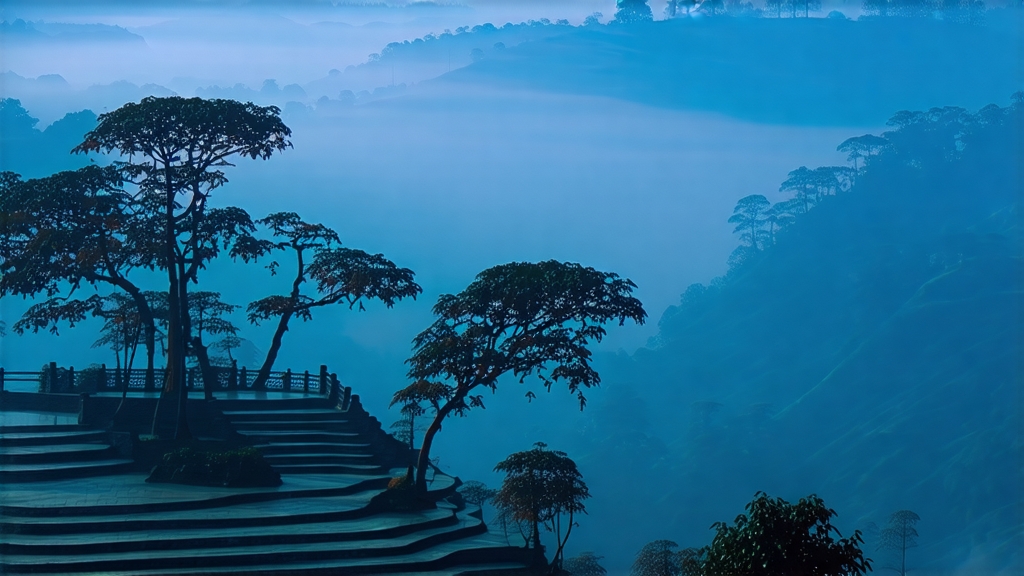
High above the torrents of the Han River, in the rocky folds of Guangdong’s Wudong Mountain, grows one of China’s most perfumed oolongs—Phoenix Dancong. Literally “single-bush,” Dancong once meant tea picked tree-by-tree; today the name signals a family of fragrant oolongs descended from centuries-old specimens scattered across the 1,000-metre granite ridges of the Phoenix Range. To international drinkers the term may sound cryptic, yet every sip is an olfactory map of southern China’s sub-tropical forests, where fogs, mineral springs, and indigenous honey-peach, ginger-flower, and orchid aromas have been trapped in leaf for almost a thousand years.
Historical roots
Song-dynasty chronicles (960-1279) already record “Phoenix tribute tea” carried by porters to the imperial court. Local legend adds colour: a Song emperor fleeing Jurchen cavalry rested beneath a giant tea tree, brewed its leaves in his helmet, and delighted in the natural honey fragrance. He named the tree Song Zhong—“Song variety”—and imperial demand spurred villagers to graft and transplant cuttings, creating the first clonal garden. By the Ming, Dancong had become tax payment in leaf form; by the Qing, tea merchants from Chaozhou’s bustling river port shipped compressed Dancong bricks to Southeast Asia, embedding the tea in diasporic Teochew culture. When oolong crafting techniques migrated from Fujian in the late nineteenth century, mountain farmers adopted shaking, bruising, and charcoal baking to fix the elusive aromatics, giving birth to the modern Phoenix Dancong style we recognise today.
Micro-terroir and ancient bushes
Wudong’s terroir is extreme: steep granite slopes, diurnal temperature swings of 15 °C, and year-round cloud cover that filters sunlight into soft, aromatically preserving rays. The soil is a skeletal mix of coarse sand and feldspar that drains within minutes yet harbours just enough organic matter from fallen pine needles. In this stress-filled environment, tea trees age slowly; trunks of 200- to 600-year-old specimens are as thick as rain barrels, their gnarled roots plunging into crevices in search of trace minerals. Each ancient bush expresses a unique fragrance, so villagers gave poetic names—Honey Orchid, Ginger Flower, Almond Fragrance, Night-Blooming Jasmine, Eight Immortals—to mark the sensory fingerprint. Over centuries, cuttings from these mother trees were transplanted into higher or lower elevations, creating a palette of micro-cultivars that all fall under the umbrella term Dancong.
From leaf to aroma: the craft
Unlike the rock-solid uniformity demanded by commodity tea, Dancong celebrates variation. Picking begins at the end of March when two leaves and a bud still wear a faint down and the morning mist clings to the ravines. The goal is not bulk but aromatic potential, so pluckers select only the most fragrant bushes, often finishing a single 300-year-old tree before moving to the next.
Withering starts outdoors on bamboo racks set in shade; the leaves lose stiffness without direct sun, allowing internal carotenoids and amino acids to pre-asduce floral precursors. The critical step is yaoqing—“shake-green”—a rhythmic tossing in shallow wicker trays that bruises leaf edges while keeping the veins intact. Oxidation proceeds unevenly: edge turns reddish-brown, centre stays green, creating the typical “green belly with red skirt” that connoisseurs look for. After 4–7 repeats across a sleepless night, the master sniffs the pile; when peach and honey notes peak, firing begins.
A 230 °C drum kill-green locks the aroma, followed by rolling to twist leaves into the signature dark, snail-like strips. The most labour-intensive phase is charcoal baking: low-temperature roasting over embers of local longan wood lasts 6–10 hours, rests for a week, then repeats up to three times. Between bakes the tea is cupped; if the roast threatens to mask the original fragrance, the craftsman shortens the next cycle. The result is a paradox—leads that smell of smoked apricot yet infuse into a bright, crystalline liquor.
Grades and garden styles
Contemporary Dancong is marketed in overlapping tiers. At the summit are Single-Tree lots: all leaves come from one numbered ancient bush, yielding perhaps two kilograms a year. Next are Grove teas—le